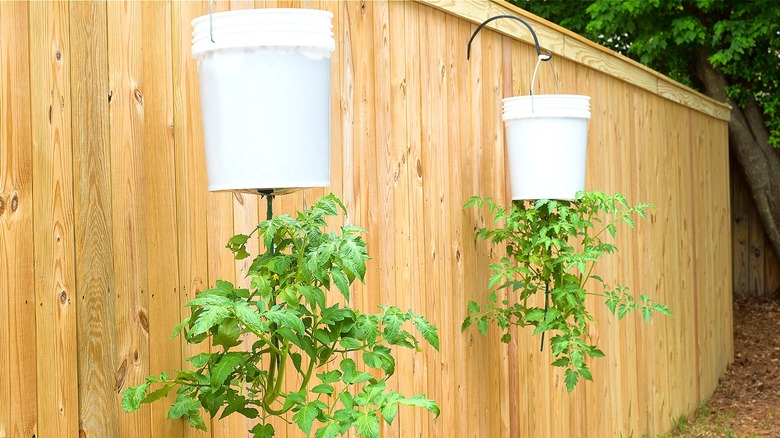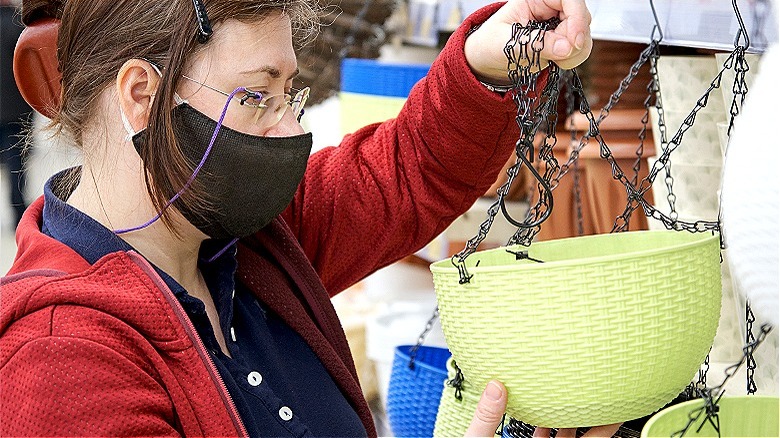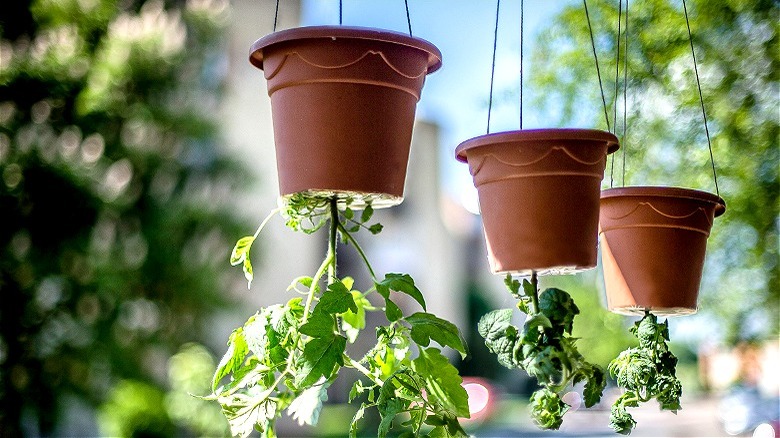How To Grow Tomato Plants Upside Down (And Why You'd Want To)
Having a ready supply of sweet, delicious, and nutritious homegrown tomatoes is the dream. But growing these vegetables (scientifically, fruits) involves quite a bit of space that could pour hot water on all your fancy cooking plans if you've got a small garden area. However, there's a way out: Simply grow your tomato plants upside down in hanging containers. This means you sow the seedlings in the pot but then invert its position. So, the plant's roots are at the top, while the tomatoes and stems are ground-facing.
But what's the benefit of this gardening setup? Beyond the space it saves, growing tomatoes upside down also helps the tomatoes. From greater air circulation to mobility to protection from soil-borne diseases and pests, growing tomatoes upside down from suspended containers is a gardening hack even people with ground space may want to try. What's more, you can easily DIY your own hanging planter out of a spare bucket (see above).
Growing tomato plants upside down
The first step, of course, is to determine the best tomato variant for your garden. Note, not all tomatoes will do well when growing upside down. Given that hanging planters can weigh more than 50 pounds, it's best to select varieties with small fruits like cherry, red currant, or grape tomatoes to limit the weight they add to the branches and the container. Next, pick a specialty hanging planter or make your own by drilling out a 2-inch long gap at the bottom of a 5-gallon plastic bucket. While you can swap out plastic for fabric, it isn't recommended as fabric's high porosity prevents the flora from staying hydrated for long.
With the basic prep out of the way, proceed to add landscape material or window screens to the planter's bottom. You can alternatively cover it with a few layers of newspaper. Then, load ¾ of the container with potting soil, followed by vermiculite. Be sure to leave about 2 to 3 inches of room at the top. Also, don't use ground soil, as it drains poorly and adds unnecessary load.
If using a bucket, cover it with a lid. To insert the seedling, you'll need to tip the planter on its side, so covering it will help keep any of the soil mix from falling out. Next, make a cross-cut in the soil and landscape material mix at the bottom side, and then insert your tomato seedling. To protect the roots during insertion, cover it with a newspaper. Finally, hang the planter with a strong hook and wait for the harvest.
Why growing tomatoes upside down makes sense
Growing tomato plants in containers and hanging them upside down might seem radical, but there are practical reasons gardeners may choose to do so. One reason is the method's ability to make the best use of space constraints. These vertical growers can provide bountiful tomato harvests even when hung on patios and balconies, eliminating the need for any ground room. Moreover, by being hung, they enjoy better air circulation, facilitating pollination.
Moreover, upside-down tomato plants are less exposed to soil. So, they run a lower risk of attracting soil-borne pests and diseases, such as ground fungus, cutworms, and blight. Their limited soil layers also prevent weeds from taking root in the planter. Further, as these plants no longer spread out or fall over under their weight, you can do away with staking to maintain a tidy look.
Best of all, if sitting down to tend to plants isn't possible anymore for you, an inverted tomato container provides a way out. You can simply tend to them while standing. You can even move the planters as needed to ensure they get the right amount of sunlight, which, as noted, isn't possible with ground-planted tomatoes.


